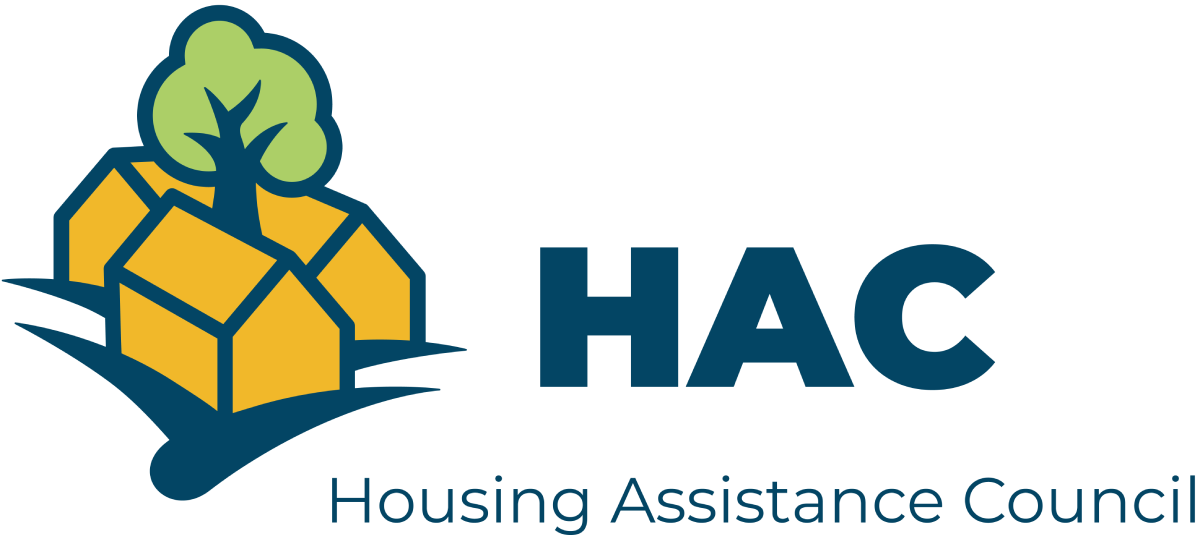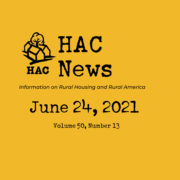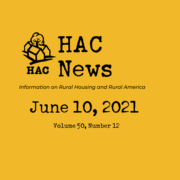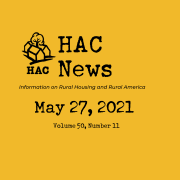HAC News: June 24, 2021
June 24, 2021
Vol. 50, No. 13
TOP STORIES
President can replace FHFA director at will, Supreme Court rules.
In a decision issued on June 23, the Supreme Court invalidated a provision of the Federal Housing Finance Authority’s governing statute that allowed the president to remove FHFA’s director only for cause. Director Mark Calabria immediately resigned and President Biden named Sandra L. Thompson the agency’s acting director.
Federal eviction and foreclosure moratoriums extended to July 31.
On June 24, Centers for Disease Control Director Rochelle Walensky announced an extension until July 31 of the federal moratorium on evictions of tenants whose finances have been impacted by the pandemic. CDC’s extension order states that, “absent an unexpected change in the trajectory of the pandemic, CDC does not plan to extend the Order further.” The Federal Housing Finance Agency also extended to July 31 its moratorium on foreclosures and evictions of homeowners whose mortgages are owned by Fannie Mae or Freddie Mac. Additional federal actions and guidance to assist tenants and homeowners are described in a White House fact sheet.
Congress begins work on FY22 spending bills.
The House Appropriations Committee released its FY22 bill for USDA on June 24 and its Agriculture Appropriations Subcommittee is scheduled to mark up the bill on June 25. The bill proposes higher funding levels than the administration’s budget for rental housing preservation and for home repairs. See HAC’s website for more details. The House Transportation-HUD Appropriations Subcommittee markup is set for July 12. The full House committee will review the USDA bill on June 30 and the HUD bill on July 16. The Senate Appropriations Committee has not yet released its schedule.
HUD proposes to reinstate fair housing disparate impact rule.
A proposed rule would cancel the regulatory changes proposed by the Trump administration in September 2020. The 2020 changes have not gone into effect because of a preliminary injunction issued in a lawsuit challenging them. Comments are due August 24 on HUD’s proposal to reinstate its 2013 rule, which has remained in effect while the lawsuit proceeds. For more information, contact Kathleen M. Pennington, HUD, 202-402-3330.
Torres Small nominated for RD Under Secretary.
President Biden has nominated Xochitl Torres Small, formerly a member of Congress from New Mexico, to serve as USDA’s Under Secretary for Rural Development. HAC CEO David Lipsetz commented, “She’s a leader dedicated to the communities @usdaRD serves, and she’d do great work at its helm.” The previous administration had eliminated this position. After stakeholders, including HAC, objected, Congress reinstated it in the 2018 Farm Bill, but only the Deputy Under Secretary position was filled.
Pandemic amplified housing inequities, reports Harvard’s Joint Center.
The State of the Nation’s Housing 2021 reports that, even as the U.S. economy recovers from the effects of the pandemic, millions who lost income are behind on housing payments and on the brink of eviction or foreclosure. Households with low incomes and people of color comprise a disproportionately large share of those at risk. The authors conclude that further government support, in addition to the steps taken so far, will be necessary to ensure that all households benefit from the expanding economy. HAC is a sponsor of the State of the Nation’s Housing report, which is published by Harvard’s Joint Center for Housing Studies.
RuralSTAT
Issuance of permits for new housing construction fell in core counties of large metro areas in 2020, but increased 12% in their suburban counties, 10% in smaller metros, and 9% outside metro areas. Source: State of the Nation’s Housing 2021.
OPPORTUNITIES
USDA’s new RISE program will fund job accelerators.
The Rural Innovation Stronger Economy program offers grants to support job accelerator partnerships that improve the ability of distressed rural and energy communities to create high wage jobs, accelerate the formation of new businesses, and identify and maximize local assets. Nonprofits, for-profits, local governments, tribes, and others are eligible and can apply by August 2. For more information, contact an RD state office. Comments are due August 16 on the Rural Business-Cooperative Service’s final rule for the program, which took effect on June 15. For more information on the rule, contact Sami Zarour, USDA, 202-720-1400.
Healthy Homes and Weatherization Cooperation Demonstration grants offered.
HUD will make grants for demonstrations that coordinate HUD’s Lead Hazard Reduction Healthy Homes program with the Department of Energy’s Weatherization Assistance Program to determine whether this coordinated delivery of services achieves cost-effectiveness and better outcomes. Deadline is August 17. For more information, contact Brenda M. Reyes, HUD, 202-402-6745.
IRS tool helps non-filers claim child tax credits and economic impact payments.
People who were not required to file 2020 income tax returns can use an online IRS sign-up tool to claim the Child Tax Credit provided by the American Rescue Plan. Part of this credit will be paid in monthly installments from July through December 2021 rather than, as is usually the case, requiring parents to wait until they file their tax returns to claim it. The tool also allows non-filers to request Economic Impact Payments (also known as stimulus checks) from any of the three rounds of coronavirus relief.
HAC seeks Community Facilities Housing Specialist.
The Community Facilities Housing Specialist identifies and engages community stakeholders and provides direct technical assistance to rural organizations that are developing facilities such as parks, community centers, public libraries and childcare centers. This includes helping them identify, utilize, and apply for financial resources such as USDA Community Facilities grants and loans. This is a two-year position and is eligible for telecommuting.
CORONAVIRUS
“Neighborhoods with highest eviction filing rates have lowest levels of COVID-19 vaccination.”
Princeton University’s Eviction Lab reports that, in nine cities for which data was available, the zip codes with higher eviction filing rates were more likely to have lower vaccination rates. The highest eviction rates tend to be in neighborhoods with high Black and Latinx populations.
REGULATIONS AND FEDERAL AGENCIES
USDA seeks input on advancing racial justice and equity for underserved communities.
The department requests comments to help identify barriers that people of color and underserved communities and individuals may face in accessing, enrolling in, and participating in any of USDA’s programs and services, and engaging with USDA staff. Responses are due July 15. For more information, contact Liz Archuleta, USDA, 202-720-7095.
Disparities in home appraisals under review.
On June 1 the Biden administration announced new efforts to reduce the racial wealth gap, including an interagency initiative to address inequity in home appraisals. According to Politico, the working group, led by HUD Secretary Marcia Fudge, will begin work in July and produce a report within 180 days. CFPB also recently held a virtual discussion on the subject.
Fact sheet updated for USDA tenants displaced by natural disasters.
Current USDA RD multifamily tenants displaced by natural disasters have priority eligibility for other properties financed by USDA or HUD. USDA has updated its fact sheet for tenants, available in English and Spanish.
Courts put debt relief for disadvantaged farmers on hold.
A federal judge issued a preliminary injunction on June 23 temporarily blocking the administration’s program to pay off farm loans for disadvantaged farmers and ranchers while the court considers a suit brought by white farmers challenging the plan. Another federal judge had issued an order pausing the program on June 10, and additional lawsuits have been filed.
PUBLICATIONS AND MEDIA
Podcast reimagines rural policy.
A new three-part series from the Brookings Institution and the Rural Matters podcast urges a change in the federal approach to rural policy. The first episode focuses on rethinking rural policy, episode two looks at designing policy to best serve diverse rural populations, and the third episode highlights the importance of capacity building as a vehicle for improving rural communities. Rural Matters is available on all major podcast platforms.
FAQs and tips on Emergency Housing Vouchers available.
A National Housing Law Project summary answers questions and offers advocacy suggestions for HUD’s new Emergency Housing Vouchers, which have some important differences from Housing Choice Vouchers.
Annual Kids Count report shows disparate outcomes.
The Annie E. Casey Foundation’s 2021 KIDS COUNT Data Book presents figures and trends on child well-being through 2019 and looks at the impact of the coronavirus pandemic on children’s access to food, health care, housing, and education. The analysis finds that, despite gains for children of all races and income levels before the pandemic, nearly all index measures show children experience disparate outcomes based on race/ethnicity and income. AECF recommends making the expansion of the federal Child Tax Credit permanent, strengthening state and local policies affecting children and families, and prioritizing racial and ethnic equity in policymaking.
Commerce Department maps broadband needs.
A new interactive digital map from the National Telecommunications and Information Administration shows data at the county, census tract, and census block level for key indicators of broadband need: broadband access, speed, and availability of equipment, as well as poverty. Data can also be viewed for tribal lands.
“As the climate emergency grows, farmworkers lack protection from deadly heat.”
Civil Eats reports on studies by the Vermont Law School’s Center for Agriculture and Food Systems and the Johns Hopkins Center for a Livable Future that describe the inadequate legal protections for farmworkers’ health and the public health threats they face, including danger from extreme heat.
“Rural Kansas is falling far short of supplying needed housing. The shortfall is stifling hopes of growth.”
The Topeka Capital-Journal covers how the limited supply of housing is fueling skyrocketing prices. The barriers to building new homes can be described by the “five Ls”: labor, land, lending, laws, and lumber. Currently, the costs to build houses in rural areas require prices higher than local residents can afford.
Need capital for your affordable housing project?
HAC’s loan fund provides low interest rate loans to support single- and multifamily affordable housing projects for low-income rural residents throughout the U.S. and territories. Capital is available for all types of affordable and mixed-income housing projects, including preservation, new development, farmworker, senior and veteran housing. HAC loan funds can be used for pre-development, site acquisition, site development, construction/rehabilitation and permanent financing. Contact HAC’s loan fund staff at hacloanfund@ruralhome.org, 202-842-8600.
Please note: HAC is not able to offer loans to individuals or families. Borrowers must be nonprofit or for-profit organizations or government entities (including tribes).






